Books, Handbooks and Guides for Neotropical Birding you Have to Know
Birding in the Neotropics can be difficult, due to the great diversity of birds and ecosystems. South America has more than 3400 bird species, which is more than 30% of the birds of the World. It is also the continent with the most number of birds in the World. As mentioned before in a previous entry, this is the second part of a blog series about field guides for neotropical birding and books.
In this post I will focus on other literature about South American birds and the neotropical birders’ library, to help you . This literature, however, is very useful in a Colombian context as well. Some of you might consider taking one of the books discussed below into the field with you, but most will find them to be too large, instead serving as references in preparation of your trip.
Table of Contents
Neotropical birders’ library
Birds of Northern South America, 2006.
by Robin Restall, Clemencia Rodner & Miguel Lentino & Robert S. R. Williams. 2006.
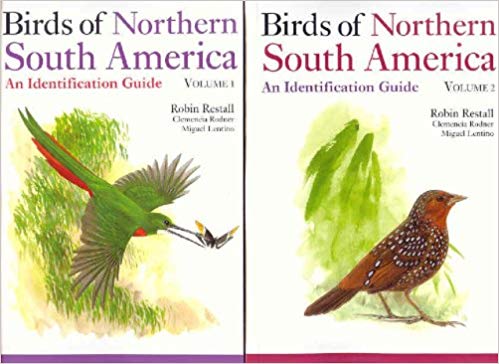
This tremendous and complementary 2-volume set covers the entirety of Northern South America (Ecuador, Colombia, Venezuela, Aruba, Curazao, Bonaire, Trinidad and Tobago, Guyana, Suriname and French Guiana). All species recorded in the continent up until 2006 are covered.
Volume 1.
Birds of Northern South America: Identification guide, Vol. 1: Species account by Robin Restall, Clemencia Rodner & Miguel Lentino & Robert S. R. Williams (2006, ISBN: 978-0713672428).
Volume 1 harbors a brief introduction, followed by the written accounts for 2300+ species occurring in the region! The text is not as thorough as in other publications about the region but none the less treats the subspecies of respective areas very well. Remarks aiding bird identification are also providing, such as status, habitat and taxonomical issues. The voice is transcribed and further enhanced by the appendix, listing published recordings for each species.
Volume 2.
Birds of Northern South America: Plates and Maps, Vol.2: An identification Guide by Robin Restall, Clemencia Rodner, Miguel Lentino & Robert S. R. Williams, illustrated by Robin Restall (2006, ISBN: 978-0713672435).
Volume 2 is the identification guide for neotropical birding, is smaller but still quite bulky for field use. Double-page spreads show illustrations of 4 – 14 species per plate so that similar species are readily comparable. All illustrations are made by Robin Restall. Distribution maps of all species are usually clustered together on the left page. As typical for many Bird Guides of the region, there is much blank, unused space.
Although one is able to identify many of the vast region’s bird species, you will struggle using this field guide volume on its own, as illustrations range from good to poor. Within Tyrannidae (and several other families…), you will encounter several mistakes and inaccuracies. In some cases, species are depicted with the totally wrong eye-color, wing pattern etc., and these errors make correctly identifying birds impossible without additional knowledge. Furthermore, the jizz of several other species are not that well captured and are sometimes at odd.
A lot of different plumages of one species and their sub-species are depicted. A huge bonus!
The Birds of South America by Robert S. Ridgely, illustrated by Guy Tudor, 1989.
The 2-volume set was for a long-time ahead of its time, but now is quite outdated. They are part of a 4-set volume plan that endeavoured to cover all the birds of South America. Thus far, only two volumes have been published: The Oscine Passerines, Vol. I. and the Suboscine Passerines, Vol. II. The other 2 volumes were to cover the non passerines (Land birds), Vol. III, and the non passerines (Water birds), Vol. IV, but they will never appear, as plans were buried for these volumes soon after the work’s initial publication.
Volume 1. The Birds of South America: The Oscine Passerines by Robert S. Ridgely, illustrated by Guy Tudor (1988, ISBN: 978-0292707566)
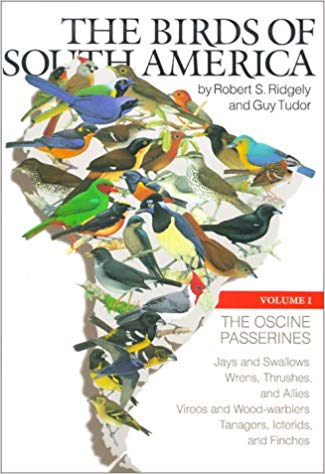
Volume 2. The Birds of South America: The Suboscine Passerines by Robert S. Ridgely, illustrated by Guy Tudor (1993, ISBN: 978-0292770638)
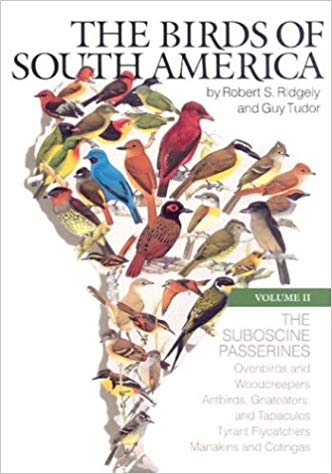
The illustrations plates in both volumes are bundled together in the middle section of the books. Not every bird species of South America is illustrated, as many are summarized as similar species to the ones depicted.
Guy Tudor’s color plates still rank as probably the best, most accurate, and artistic paintings of Neotropical avifauna. They are truly timeless…
Ridgley’s text provides a lot of information about South American Avifauna and Latin American Ornithology at the beginning of the volumes. In each volume, the identification, status, and voice are described, and there are halftone range maps for every species.
It as inspirational as it is indispensable for any bibliophilic ornithologist.
Field Guide to the Birds of South America: Passerines, 2009.
by Robert S. Ridgely, illustrated by Guy Tudor (2009, ISBN: 978-1408113424)
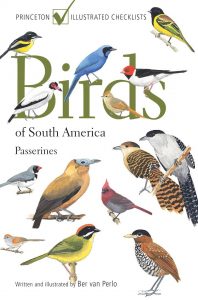
This is another birding guide for neotropical birding. It is a single-volume concise edition from the above described volumes. For this edition, the text has been condensed, and many of the missing species that were not illustrated before have now been painted. New maps have been compiled for every species covering all South America!
Birds of Peru, 2007.
by Thomas S. Schulenberg, Douglas F. Stotz, Daniel F. Lane, John P. O’Neill and Theodore A. Parker III, illustrated by 13 artists. (2007, ISBN: 978-0-7136-8673-9)
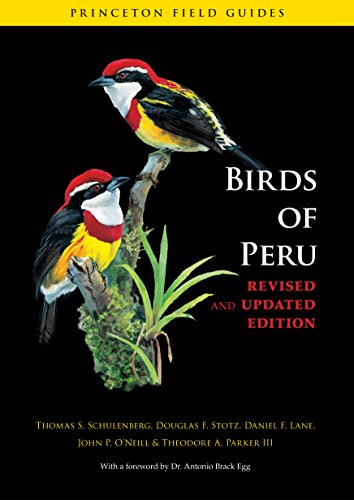
Peru shares the vast Andean mountain range and large tracts of the Amazonian biome with Colombia. If you intend to visit the southern region of Colombia for birding (around Leticia), neighboring Peru shares most or all of its species with Colombia. There, this guide can prove useful. A large portion of widespread Andean birds can be found in both countries and are covered in this book.
It still ranks high as one of the best modern field guides in South America. Its’ origin dates back to John P. O’Neill’s and Ted Parker’s intense field work in the 80s and 90s. Ted Parker was among the individuals who revolutionized contemporary neotropical field ornithology. His contributions cannot be overemphasized, but both men mentioned above laid the foundation for this guide. Parker’s premature death halted the book’s plan. Luckily, they were picked up again by an illustrious team of authors and illustrators that finished this impressive book.
Its size -14,8 x 3,7 x 20,9 cm- makes it easy to take in the field. The introductory section is typical for a modern guide, and the taxonomy largely follows that of the South American Classification Committee (SACC). It devotes 2 plates to bird topography, normally omitted by many other regional field guides. It contains detailed explanations on how to use the guide and includes clear maps showing topography, major rivers, the location of protected areas, and political units.
The plate section shows each species portrayed opposite the text and maps. The text includes information on abundance, elevational, and distributional information; notes on different subspecies; a transcription of voice; and sometimes notes on distinctive habits that are helpful for field identification. Thirteen artists have illustrated the plates, so there are inevitably big differences in style and quality. But most of them are very good and accurate. At the end you will find vocal credits and references, artist credits, and an index.
The Handbook of the World Series (HBW), 1992–2013.
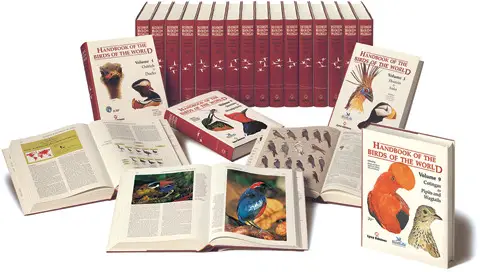
What is probably the most impressive, thorough, & beautiful work about birds currently available for the neotropical birders’ library, is the The Handbook of the World Series (HBW). This work was compiled over 18 years and contains 16 volumes with the gargantuan task of treating all the living bird species of the world with text and illustrations!
I will give only a short, general summary about the series, as all the volumes share a common denominator throughout: Pure excellence! Further, I will list volumes of big interest from a Neotropical birder’s point of view.
Every single volume of this encyclopedic work is quite large, weighing 4.5 kg coming in at 24x31x5 in dimension. It will certainly test the stability of your bookshelf. Eleven of the volumes have an introductory foreword discussing various topics concerning ornithology, ranging from introducing the work itself, art & nature, and avian bioacoustics to ornithological nomenclature, climate change, and more!
Each family is covered and introduced separately by the foremost authorities on the subject who cover covering everything from general info to systematics, morphological aspects, and almost ALL biological aspects of the family. The chapters are accompanied by outstanding color photographs, many of which have never been published. All species known to exist up until publication of each respective volume are included and illustrated by various artists who are considered to be among the best in their fields.
Artistically, they are all of highest level, with minor errors. For each species there is a thorough description; however, this description is not aimed to assist in identifying these birds. The accounts are aided by range maps. At the end you find a huge bibliographic index. For species discovered after a volume’s publication, this group has created a new Special Volume: New Species and Global Index.
Listed below there are volumes of particular interest to Neotropical ornithologists and birders:
Handbook of the Birds of the World – Volume 5: Barn-owls to Hummingbirds
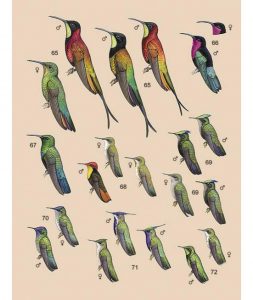
Handbook of the Birds of the World – Volume 8: Broadbills to Tapaculos
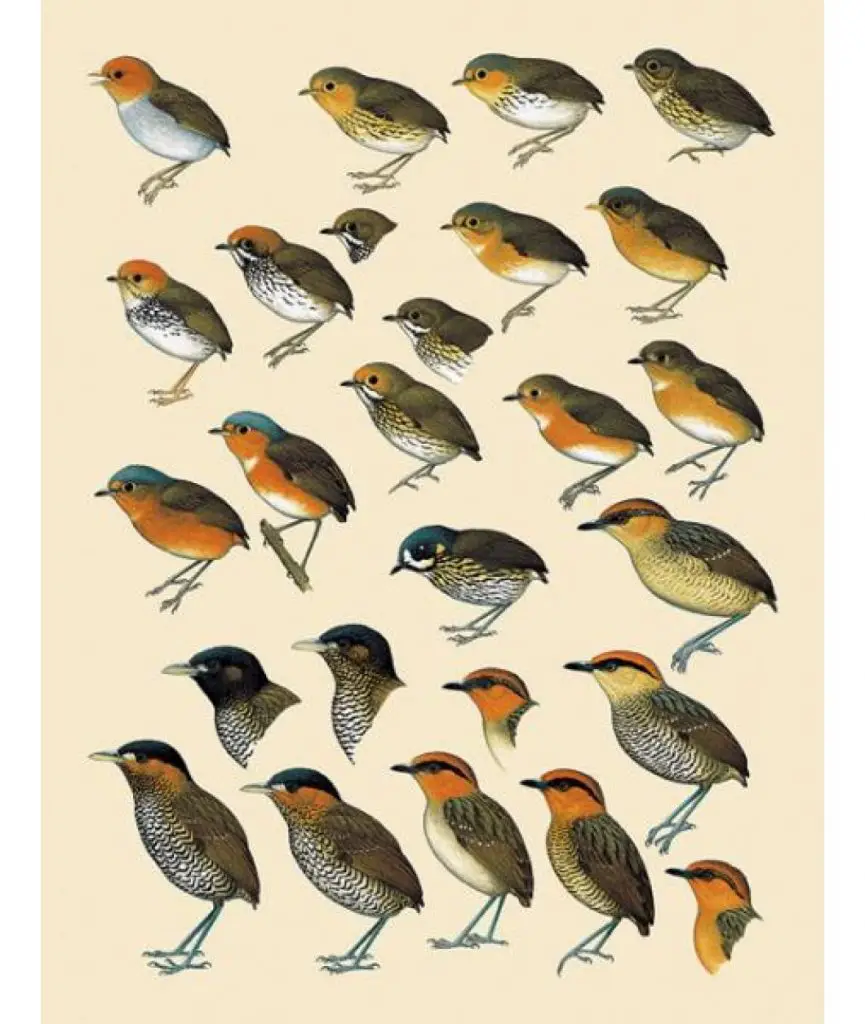
Handbook of the Birds of the World – Volume 9: Cotingas to Pipits and Wagtails
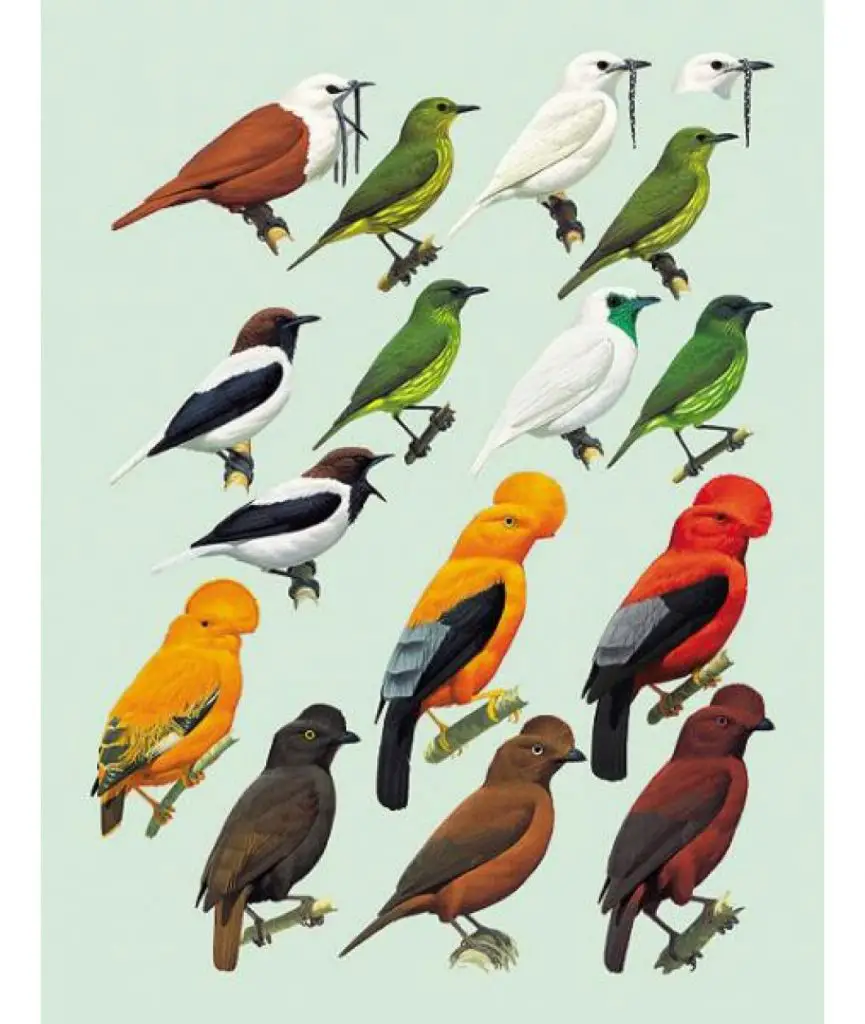
Handbook of the Birds of the World – Volume 16: Tanagers to New World Blackbirds
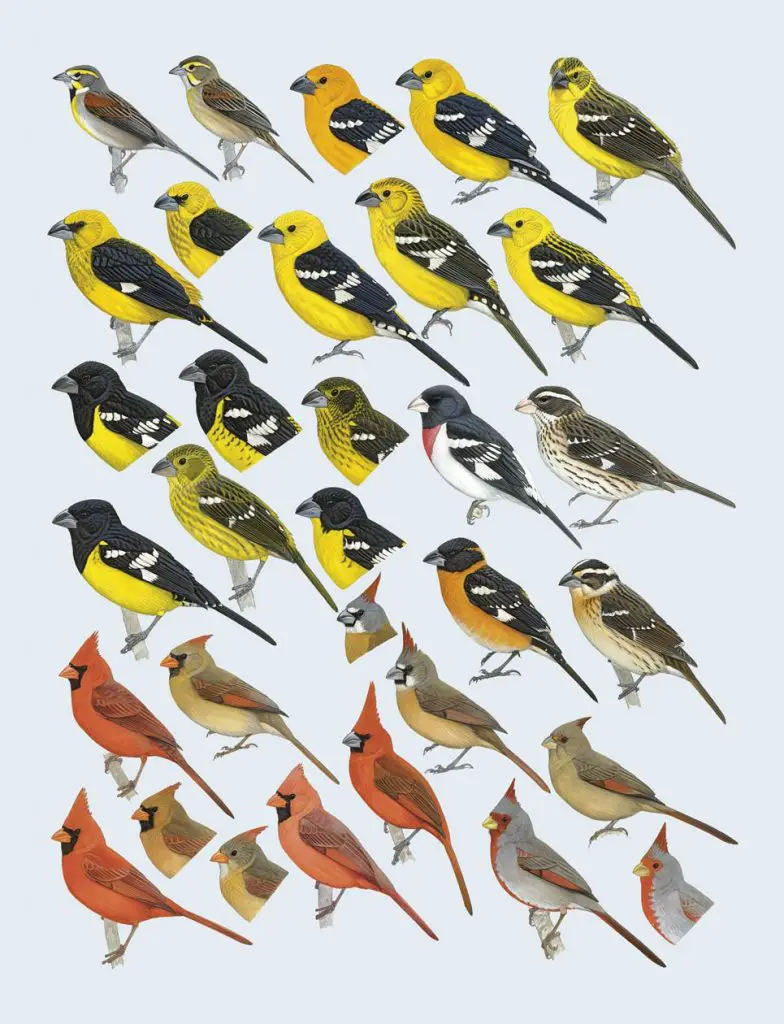
Visit www.lynxeds.com/product-category/by-categories/encyclopedias/hbw to learn more about the HWB-series, authors and artist credits. Every single volume is presented there.
Tip: The whole series is available online at www.hbw.com. The online version is updated frequently, and in addition, you can keep your lists there, using the sites excellent features. Birdlife/HBW has its own taxonomic system (more about that in this Blog) and is further linked to the Internet Bird Collection (IBC). Rumor has it that there will be a fusion between HBW and Cornell University in the nearer future!
Helm Identification Guide Series, 1980s – 2020 current
For the sake of completeness, I will list some excellent monographs of the famous Helm Identification Guide Series (available through the NHBS book-store, mentioned below) dealing exclusively with Neotropical/New World bird families. I did not include available monographs of families occurring in the neotropics, but I do cover the whole world (See HBW above). These monographs provide the most detailed information about any of these families, especially concerning species-level. They are not revised in detail. You’ll find very brief notes, instead.
- Antpittas and Gnateaters, by Harold Greeny, illustrated by David Beadle (2018, ISBN: 978-1472919649)
Beautiful new book about some of the most highly-prized, elusive and least-known of all species in the Neotropics! Includes photos & excellent artwork
- Cotingas and Manakins, by Guy M. Kirwan & Graeme Green, illustrated by Eustace Barnes (2012, ISBN: 978-0691153520)
Excellent and thorough from A-Z. Includes photos & excellent artwork
- New World Blackbirds: The Icterids by Alvaro Jaramillo & Peter Burke, illustrated by Peter Burke (1998, ISBN: 978-0713643336)
Somewhat less appealing than the other above-mentioned ones, still very detailed. No photographs but nice artwork.
- The Tanagers: Natural History, Distribution & Identification: Natural History, Distribution, and Identification by Morten S. Isler & Phyllis R. Isler, (1999, ISBN: 978-0874745535)
Not matching standards of the precedent books. Its artwork is not as elaborated and accurate, either. No photos.
Journals
If you like to read magazines there are:
Cotinga
Cotinga is published once a year and you can subscribe at www.neotropicalbirdclub.org/nbc-publications. Cotinga is the most important magazine for publications about birds in Latin American countries! It is peer-reviewed and published in Spanish, English and Portuguese.
Neotropical Birding
Neotropical birding is published twice a year and you can subscribe at www.neotropicalbirdclub.org/nbc-publications. Neotropical birding is devoted to all topics concerning birdwatching in the Neotropics. Articles range from identification, bird watching areas/reserves presented, taxonomic issues, book-reviews & much more! It is richly accompanied by color photographs throughout. Of Cotinga, pdf versions are available online.
Applications
technological abilities have evolved dramatically over the last century. Nowadays you can find digital archives accessible to everybody containing the world’s largest collection of plants, animals, sounds and videos. We invite you to explore some of them which has been created for ornithology and birdwatching.
All Birds Colombia – A Sunbird Field Guide
There is also a (payable) bird app, “All birds Colombia”, for Android and IOS from Sunbird based on this volume’s work! The app is not revised here, wait for future reviews on this and other birding apps.
Merlin
Merlin is a platform and application launched in 2014 by The Cornell Lab of Ornithology at Cornell University in the United States. Merlin is based on more than 800 million sightings submitted to eBird citizen-science project platform from birders around the world. It was designed to beginning and intermediate bird watchers. It is free and can be used in both Android and iOs operating systems.
Merlin asks you to describe the color, size, and behavior of the bird you saw. Then, Merlin shows you a shortlist of possible bird species based on descriptions from Cornell Lab experts and collaborators. More than 3 million descriptions help Merlin to match your input with the most likely birds. When you identify a species and click “This is My Bird,” Merlin also saves your record to help improve its future performance.
The downside of this application is that rare or unreported birds on the eBird platform do not appear in the records. Making it necessary to use books in the field. It also depends on an internet connection to be able to access the platform in real time, which is difficult in many places in the Neotropics.
One way to avoid having to connect to the internet is to download the bird packs by region to your device. However, these regionally-based bird packages take up a lot of memory and you may not have space to store them, or your device may be slowed down.
All About Birds
This is an online guide to birds and bird watching. It is a free resource available for everyone and funded by donors.
At the current time of writing this blog, all books discussed here are available. Check for instance www.wildsounds.com/menu/main.shtml, www.nhbs.com/books, www.buteobooks.com, www.lynxeds.com, www.amazon.com, and of course your local book-store!
We hope peaked your interest with this selection of truly stunning literature. It is quite a challenge selecting which guide to take in the field, but in preparing for your trip and reading these guides, I hope you enjoy immersing yourself in the wonderful world of birds. And there are many more books available…
About the authors
Jérôme Fischer
Professional bird guide, swiss native, with more than 32 years of experience guiding hardcore birders and birdwatching tours. He has been focused in bird identification. He also travelled many countries, starting in Switzerland and then exploring south America, the most biodiverse continent in the world, becoming specialized in Neotropical birds.
Sara Colmenares
Current director of Sula. Doctor in Biological Sciences. Her main interests are to explore and understand the organism – environment interactions, taking advantage of emerging knowledge for the management and conservation of species and ecosystem services. She is currently working as a consultant in functional ecology, ecosystem services and conservation projects in Colombia related to ecotourism and birdwatching.
